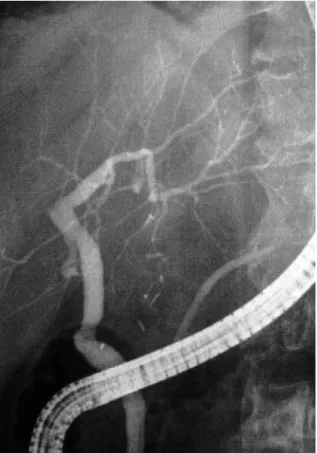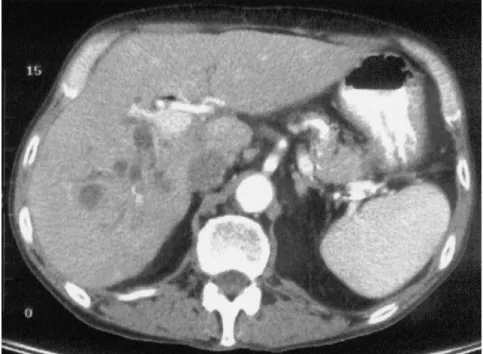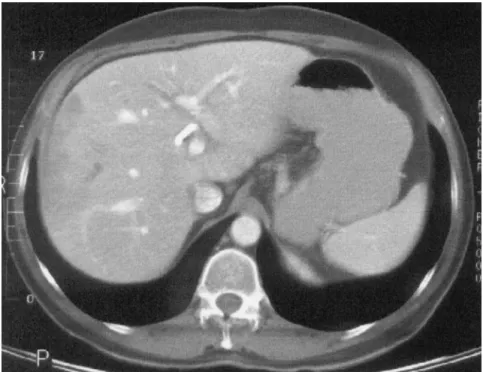Pierre Honore´, Olivier Detry, Etienne Hamoir, Thierry Defechereux,
Bernard Detroz, Michel Meurisse, and Nicolas Jacquet
Retransplantation is common after liver transplantation (LT). However, in the present era of organ shortages, every attempt to save the liver graft should be performed before considering retransplantation. We report our expe-rience with right hepatic lobectomy (RHL) for liver graft salvage. In a retrospective series of 180 adult LTs, 4 pa-tients underwent RHL (Couinaud’s segments V, VI, VII, VIII) in the post-LT period. In all cases, the procedure was performed without Pringle’s maneuver or mobilization of the left liver lobe to preserve its vascularization. Three liver graft recipients developed intrahepatic biliary stric-tures, mainly localized to the right lobe of the graft, and RHL was performed 14, 75, and 78 months after LT. These patients were alive at last follow-up without further episodes of cholangitis or retransplantation (mean follow-up, 38 months). The fourth patient developed early post-LT right liver necrosis with a functioning hepatic artery and underwent right lobectomy 48 hours after LT. He later developed cholangitis secondary to late hepatic artery thrombosis, requiring retransplantation after 18 months. We conclude that RHL can be considered a graft-saving option in selected liver transplant recipients with localized biliary strictures, with excellent patient and graft survival. (Liver Transpl 2001;7:269-273.)
L
iver transplantation (LT) has become the standard of care for many end-stage liver diseases. LT sur-gery and immunosuppressive protocols improved with experience, leading to excellent results in terms of pa-tient survival and quality of life after LT. The main limitation to LT has been the cadaveric organ donor shortage. In the United Network for Organ Sharing (UNOS) area, the median waiting time for a liver trans-plant was 515 days in 1998, and even longer for status 3 liver transplant candidates.1 This year, 1,317 livertransplant candidates died on the UNOS waiting list.1
This shortage and, in particular, the increasing death toll in adult candidates has forced the transplant com-munity to find alternative sources of grafts, such as living or non– heart-beating donors.
Retransplantation is common after LT, accounting for 9% of all LTs in 1998.1Because it requires a second
graft, it increases the organ shortage. Moreover, retrans-plantation is associated with greater morbidity and mortality.2,3Therefore, every attempt to save the graft
should be made before listing liver transplant recipients for retransplantation.
The aim of this report is to present our experience
with right hepatic lobectomy (RHL; Couinaud’s seg-ments V, VI, VII, VIII) in liver transplant recipients as a graft-saving procedure.
Patients and Methods
In a consecutive series of 180 adult LTs performed between 1987 and 1999, we retrospectively reviewed the files of 4 men who underwent RHL (Couinaud’s segments V, VI, VII, VIII) in the post-LT period (Table 1).
In all cases, classic RHL was performed without Pringle’s maneuver or mobilization of the left liver and the surrounding adhesions to preserve its collateral vascularization. Parenchy-mal transection was performed with an ultrasonic dissector using hemoclip sutures (Ligaclip; Ethicon, Somerville, NJ) and fibrin glue for hemostasis and prevention of bile leaks from the transected liver surface. A cell saver was used in all procedures. None of the patients experienced liver insuffi-ciency in the post-LT period, whereas regeneration of the remnant left part of the liver graft occurred in all patients.
Case Presentations
Patient 1. Patient 1 was born in 1967. In 1987, he
under-went LT for decompensated cirrhosis secondary to Wilson’s disease. He developed intrahepatic bile duct strictures second-ary to hepatic artery thrombosis and underwent retransplan-tation in 1989. This second LT was complicated by hepatic artery thrombosis causing extrahepatic and intrahepatic liver strictures. In 1991, he underwent bile duct reconstruction with a Roux-en-Y choledochojejunostomy and hepatic artery revascularization using in situ fibrinolysis and end-to-end anastomosis between the right gastroepiploic artery and the donor hepatic artery. The left hepatic artery was successfully
From the Department of Liver Surgery and Transplantation, Uni-versity of Lie`ge, UniUni-versity Hospital Sart Tilman, Lie`ge, Belgium.
Presented as a poster at the First Joint Meeting of the American Society of Transplantation and American Society of Transplant Surgeons, Transplant 2000, May 14, 2000, Chicago, IL.
Address reprint requests to Olivier Detry, MD, Department of Liver Surgery and Transplantation, CHU Sart Tilman B35, B-4000 Lie`ge, Belgium. Telephone: 32-4366-7645; FAX: 32-4366-7517; E-mail: oli.detry@chu.ulg.ac.be
Copyright©2001 by the American Association for the Study of Liver Diseases
1527-6465/01/0703-0112$35.00/0 doi:10.1053/jlts.2001.21318
269
desobstructed, but the right hepatic artery remained lost. The patient underwent recurrent episodes of cholangitis. Because the biliary strictures were mainly in the right biliary tree, the patient underwent RHL in 1996.
Patient 2. Patient 2 was born in 1935. He underwent LT
in 1990 for decompensated cirrhosis secondary to hepatitis C virus (HCV). In 1996, he underwent endoscopic retrograde cholangiography for recurrent cholangitis that showed a right bile duct stricture. The hepatic artery was open, assessed by Doppler ultrasonography. Endoscopic treatment with stents was not successful, and the right bile duct was considered occluded (Fig. 1). In 1996, he required hemodialysis for chronic renal insufficiency, in part related to cyclosporine therapy. In September 1996, he was hospitalized for recurrent sepsis, and abdominal computed tomography (CT) showed abscesses in the right liver (Fig. 2). He underwent RHL in October 1996 without complications and kidney transplan-tation in January 1997.
Patient 3. Patient 3, a man born in 1947, underwent
uncomplicated LT in August 1997 for decompensated HCV cirrhosis. In October 1997, he was readmitted for cholangitis. The hepatic artery was open. Retrograde cholangiography showed strictures, mainly in the intrahepatic right bile duct (Fig. 3). These strictures were treated with a temporary stent. In a few months, the patient developed 5 recurrences of cholangitis requiring hospitalizations and underwent cholan-giography several times for intrahepatic biliary strictures lo-calized in the right liver. Endoscopic treatments with stents and balloons were unsuccessful, and in September 1998, CT of the liver showed hypoperfused regions of the right liver, suggesting abscesses (Fig. 4). In October 1998, the patient underwent RHL, during which abscesses of the right liver were confirmed. The postoperative period was complicated by a biliary fistula, which was treated conservatively. Abdom-inal CT, performed to evaluate abdomAbdom-inal pain in May 1999, showed compensatory hypertrophy of the left remnant liver (Fig. 5).
Patient 4. Patient 4 was born in 1945. He developed
HCV cirrhosis complicated by a 6-cm hepatocarcinoma treated by chemoembolization in December 1996 and seg-ment VII resection in January 1997. In November 1998, he underwent LT for decompensated cirrhosis, with a Roux-en-Y choledochojejunostomy. Postoperative day 2, the pa-tient developed major cytolysis, and abdominal CT showed necrosis of the right liver (Fig. 6). At laparotomy, necrosis of
the right liver was confirmed, and RHL was performed. The hepatic artery was found to be patent. The patient left the hospital postoperative day 22 without further complications. At the 3-month follow-up hepatic Doppler examination, the hepatic artery could not be seen and thrombosis was con-firmed by selective arteriography. The patient developed pro-gressive jaundice and pruritus secondary to ischemic cholan-gitis and successfully underwent retransplantation in May 2000.
Figure 1. Endoscopic retrograde cholangiography of pa-tient 2 showing obstruction of the right branch of the intrahepatic bile duct and preserved left bile ducts.
Table 1. Patient Characteristics
Patient No.
Cause of Liver
Failure Reason for RHL
Delay Between LT and RHL RHL Hospital Stay (d) Complications Follow-Up (mo) Outcome
1 Wilson’s disease Biliary strictures 78 mo 13 None 53 Uncomplicated
2 HCV Biliary strictures 75 mo 14 None 43 Uncomplicated
3 HCV Biliary strictures 14 mo 40 Biliary fistula 19 Uncomplicated
4 HCV Ischemic
necrosis
Results
The mean postoperative stay was 21 days (range, 13 to 40 days). The postoperative clinical course was not dif-ferent from that of RHL in non–transplant patients because none of the patients developed transient liver failure or significant hyperbilirubinemia postopera-tively. Patient 3 developed a biliary fistula treated con-servatively with prolonged percutaneous drainage.
All patients were alive at last follow-up in May 2000. Patients 1, 2, and 3 did not experience further episodes of cholangitis and did not require hospitalization or retransplantation (mean follow-up, 38 months). Dopp-ler ultrasonography showed arterial flow in the left he-patic artery and compensatory hypertrophy of the left liver remnant. Patient 4 needed retransplantation 18 months after LT for intractable cholangitis and jaun-dice related to late hepatic artery thrombosis.
Discussion
LT has transformed the prognosis of most patients with end-stage liver diseases. However, LT has become the victim of its success because currently, many patients who could be saved by LT die on waiting lists because of the donor organ shortage. Facing this drama, the trans-plant community has been seeking alternative sources of organ donors, such as non– heart-beating donors, marginal cadaveric donors, or living donors for adult liver transplant recipients. In addition, retransplanta-tion uses a second donor liver, increasing the organ Figure 2. Abdominal CT of
patient 2 showing abscesses in the right liver graft lobe.
Figure 3. Endoscopic retrograde cholangiography of pa-tient 3 showing strictures mainly localized in the right intrahepatic bile ducts.
shortage. Moreover, in comparison with primary LT, retransplantation faces a greater rate of morbidity and mortality2,3and therefore should be avoided when
pos-sible. Graft rescue procedures have been described and are regularly performed to treat vascular or extrahepatic biliary complications after LT.4-6
This report presents our experience with RHL in 4 liver transplant recipients. Three patients developed in-trahepatic biliary strictures, mainly localized in the right liver lobe, for which RHL was performed 14, 75, and 78 months after LT, resulting in rescue of the graft. In the fourth patient, the right part of the liver became
necrotic 48 hours after LT, possibly related to throm-bosis of the right hepatic artery. RHL was successfully performed, and the patient was discharged postopera-tive day 20. However, this patient underwent late he-patic artery thrombosis that induced progressive is-chemic cholangitis that led to graft failure and retrans-plantation. To our knowledge, 2 other cases of RHL after LT have been reported to date in the literature, allowing rescue of the grafts.7,8 Regeneration of the
remnant of the donor liver occurred, and no liver insuf-ficiency was observed. It is now clear that a liver graft can regenerate after living donation or use of a small-Figure 4. Abdominal CT of patient 3 showing infectious lesions in the right liver graft lobe.
for-size whole-liver graft, which was considered un-proved 10 years ago.9,10Using animal models11for liver
graft regeneration, it has been suggested that cal-cineurin inhibitors may even promote liver regenera-tion.12,13In all published cases of RHL after LT, the
arterial blood supply to the left part of the liver was preserved. However, it is uncertain whether liver regen-eration is possible in a donor liver with long-standing thrombosis of the hepatic artery or portal vein.
In conclusion, these 4 cases show that RHL can be performed after LT with an outcome not different from that in normal livers. This approach may avoid retrans-plantation in rare cases of biliary strictures localized to the right part of the liver graft.
References
1. Annual Report of the US Scientific Registry for Organ Trans-plantation and the Organ Procurement and TransTrans-plantation Network—Transplant Data 1989-1998. UNOS, Richmond, VA, and the Division of Transplantation, Bureau of Health
Resources and Services Administration, US Department of Health and Human Services, Rockville, MD, 1999. Available at: http://www.unos.org/Data/anrpt.main.htm. Accessed: May 5, 2000.
2. Markmann JF, Markowitz JS, Yersiz H, Morrisey M, Farmer DG, Farmer DA, et al. Long-term survival after retransplanta-tion of the liver. Ann Surg 1997;226:408-418.
3. Facciuto M, Heidt D, Guarrera J, Bodian CA, Miller CM, Emre S, et al. Retransplantation for late liver graft failure: Predictors of mortality. Liver Transpl 2000;6:174-179.
4. de Ville de Goyet J, Gibbs P, Clapuyt P, Reding R, Sokal EM, Otte JB. Original extrahilar approach for hepatic portal revascu-larization and relief of extrahepatic portal hypertension related to later portal vein thrombosis after pediatric liver transplantation. Long-term results. Transplantation 1996;62:71-75.
5. Langnas AN, Marujo W, Stratta RJ, Wood RP, Li SI, Shaw BW. Hepatic allograft rescue following arterial thrombosis: Role of urgent revascularization. Transplantation 1991;51:86-90. 6. Langnas AN, Stratta RJ, Wood RP, Ozaki CF, Bynon IS, Shaw
BW. The role of intrahepatic cholangiojejunostomy in liver transplant recipients after extensive destruction of the extrahe-patic biliary system. Surgery 1992;112:712-718.
7. Dousset B, Filipponi F, Soubrane O, Boillot O, Houssin D, Chapuis Y. Partial hepatic resection for ischemic graft damage after liver transplantation: A graft-saving option? Surgery 1994: 115:540-545.
8. Chari RS, Baker ME, Sue SR, Meyers WC. Regeneration of a transplanted liver after right hepatectomy. Liver Transpl Surg 1996;2:233-234.
9. Koch KS, Leffert HL. Do transplanted human livers regenerate? Hepatology 1989;9:789-790.
10. Van Thiel DH, Gavaler JS, Kam I, Francavilla A, Polimeno L, Schade RR, et al. Rapid growth of an intact human liver trans-planted into a recipient larger than the donor. Gastroenterology 1987;93:1414-1419.
11. Francavilla A, Zeng Q, Polimeno L, Carr BI, Sun D, Porter KA, et al. Small-for-size liver transplanted into larger recipient: A model of hepatic regeneration. Hepatology 1994;19:210-216. 12. Tanaka N, Yamamoto H, Tatemoto A, Urabe T, Orita K.
Reg-ulation of liver regeneration by interleukin-2 and its inhibitors: Cyclosporine A and FK 506. Int J Immunopharmacol 1993;15: 211-218.
13. Kapan M, Ipek T, Sad A, Godsel S, Sirin F. Effects of cyclosporin and somatostatin on liver regeneration after partial hepatectomy in rats. Eur Surg Res 1996;28:262-269.
Figure 6. Abdominal CT of patient 4 showing ischemic necrosis of the right liver graft lobe 48 hours after LT.



